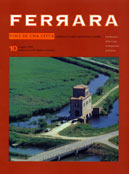The garden of the pleasaunce at Belfiore, where duke Lionello had the famous Muses painted for his study, was another arrangement of this sort, at least according to a plan that has recently been unearthed in the archives. The memory of such marvels must have been very strong if, even several decades after the devolution of the Este state to the Papacy, the ducal gardens were commemorated and described by the cartographer Alberto Penna and by the historian Marc'Antonio Guarini.
It is legitimate to suppose that the Ferrarese models were known and appreciated even outside the duchy: it suffices to think of the gardens at Montecavallo - now the Quirinal palace - in Rome, where, around 1550, Ippolito II d'Este had his collection of antiquities set out by the Ferrarese architect and painter Girolamo da Carpi; or of the garden of Villa d'Este at Tivoli, the sole survivor of at least five gardens commissioned by Ippolito, laid out according to a design by the Roman architect Pirro Ligorio around 1560.
This famous creation, laden with complex symbolic significance, seems to have a precedent in a Ferrarese garden that has disappeared: the gardens of Montagna di Sotto, improperly known as the "Bagni Ducali", laid out between 1541 and 1555.
In Ferrara, along viale Alfonso II d'Este, there are still some faint signs of the past existence of this allegorical garden, created by command of Ercole II. The principal elements of the garden were the mountain, which had two grottoes inside it, the palazzetto, which still survives although its pictorial decorations have disappeared, the geometrical garden, the copse, the fountain, the maze, the fishpond, and the pergolas.
The contrast between the mountain, the grotto, and the woodland, on the one side, and the "geometrical" garden and the palazzetto, on the other, could be an allusion to the theme of Ercole at the crossroads between vice and virtue, the essential moral significance underpinning the gardens of Villa d'Este. The maze represents the difficulties of Ercole's path while the mountain «planted with most precious vines» refers, like Parnassus, to Pliny's Hercules Musagetes.
The refinement of this design can be appreciated in one of the splendid tapestries in the "Metamorphosis" series, woven for duke Ercole II by Giovanni Karcher after a cartoon by the Filippis in 1545. The tapestry, now in the Louvre, represents with reliable faithfulness the topography of the lost garden of Montagna di Sotto.
While almost nothing remains of the famous Este gardens, we cannot overlook the fact that more recent horticultural treasures are now suffering because of an evident lack of the continuous and painstaking maintenance. The Massari and Pareschi parks, originally private but subjected for decades to heavy public use, are now in evident need of urgent maintenance, which the town council is shortly to provide. In these public parks, as in various fine private gardens, it will be necessary to work with great care and in accordance with the criteria of restoration.
In recent years several local cultural associations have promoted a series of initiatives that would seem to confirm a new and non-marginal interest on the part of the citizens concerning the city's historic green spaces. The recovery of the city's churchyards represents an important contribution to a very particular type of public green space.
The judicious restoration of the churchyards of San Francesco, San Girolamo, and Santa Maria della Consolazione has led to a general improvement in the entire urban surroundings. In Ferrara the memory of the city's renaissance gardens survives in a metaphorical sense, so to speak, and today abides in the Nineteenth century gardens of two important residences from the Este period, now transformed into museums: these are palazzo Costabili, now the National Museum of Archaeology, and the palazzina Marfisa d'Este, a municipal museum.
Recent maintenance work carried out by the Garden Club in the gardens of palazzo Costabili has restored the pleasing layout designed around the 1930s. This little garden contains all the typical renaissance elements, stylized according to late Art Nouveau tastes: the box-tree maze, the yew trees pruned in the shape of pyramids (now cones), the well, the rose bowers, and the geometrical flower beds.
Maintenance under the supervision of the Garden Club is now underway in the palazzina Marfisa d'Este too. The return of the citrus trees to the hanging garden of the Este Castle is a significant episode in this revival of Ferrara's historic green spaces. As far as Ferrara's green spaces are concerned, only two sore points remain: piazza Ariostea and the gardens of viale Cavour. These areas are in a general state of disrepair and work needs doing on the plants, the paving, and the fittings, all clearly unworthy of such important places.



